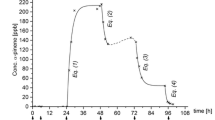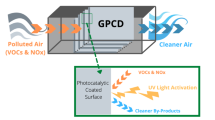Abstract
At the European level (CEN/TC386), some efforts are currently devoted to new standards for comparing the efficiency of commercial photocatalytic material/devices in various application fields. Concerning prototype or commercial indoor photocatalytic air purifiers designed for volatile organic compounds (VOC) abatement, the methodology is based on a laboratory airtight chamber. The photocatalytic function is demonstrated by the mineralization of a mixture of five VOCs. Experimental data were obtained for four selected commercial devices and three commercial materials: drop of VOC concentration, but also identification of secondary species (with special attention to formaldehyde), mineralization rates, and Clean Air Delivery Rate (CADR). With two efficient air purifiers, these laboratory experiments were compared to the results in two experimental rooms (35–40 m3) where air pollution was introduced through wooden floor and furniture. The systems’ ageing was also studied. The safety of the commercial products was also assessed by the determination of nanoparticle release. Standardized tests are useful to rank photocatalytic air purifiers and passive materials and to discard inefficient ones. A good correlation between the standard experiments and the experimental room experiments was found, even if in the latter case, the concentration of lower weight VOCs drops less quickly than that of heavier VOCs.








Similar content being viewed by others
References
AFNOR, December 2009 XP B44-13 - Méthode d’essais et d’analyse pour la mesure d’efficacité de systèmes photocatalytiques pour l’élimination des composés organiques volatiles/odeurs dans l’air intérieur en recirculation: test en enceinte confinée.
AFNOR, May 2011 XP B44-200 - Épurateurs d’air autonomes pour applications tertiaires et résidentielles - Méthode d’essais - Performances intrinsèques.
Bernstein JA, Alexis N, et al. (2008) Reviews and feature article: the health effects of nonindustrial indoor air pollution. J Allergy Clin Immunol 121(3):585–591
Bourdin D, Desauziers V (2014) Development of SPME on-fiber derivatization for the sampling of formaldehyde and other carbonyl compounds in indoor air. Anal and BioanalChem 406(1):317–328
Chen W, Gao Z, Zhang JS, Kosar D, Walker CE, Novosel D (2006) Reduced energy use through reduced indoor contamination in residential buildings, National Center for Energy Management and Buildings Technologies, Final Report NCEMBT 061106
Costarramone N, Kartheuser B, Pécheyran C, Pigot T, Lacombe S (2015) Efficiency and harmfulness of air-purifying photocatalytic commercial devices: from standardized chamber tests to nanoparticles release. Catalysis today, 8th European meeting on solar chemistry and photocatalysis. Environmental Applications 252:35–40
Desauziers V, Bourdin D, Mocho P, Plaisance H (2015) Innovative tools and modeling methodology for impact prediction and assessment of the contribution of materials on indoor air quality. Heritage Science 3:1
Destaillats H, Sleiman M, Sullivan DP, et al. (2012) Key parameters influencing the performance of photocatalytic oxidation (PCO) air purification under realistic indoor conditions. Appl Catal B Environ 128:159–170
Gunschera J, Markewitz D, Bansen B, et al. (2016) Portable photocatalytic air cleaners: efficiencies and by-product generation. Environ Sci Pollut Res 23:7482–7493
Hay SO, Obee T, Luo Z, et al. (2015) The viability of photocatalysis for air purification. Molecules 20:1319–1356
Jones AP (1999) Review article: indoor air quality and health. Atmos Environ 33:4535–4564
Kartheuser B, Costarramone N, Pigot T, Lacombe S (2012) NORMACAT project: normalized closed chamber tests for evaluation of photocatalytic VOC treatment in indoor air and formaldehyde determination. Environ Sci Pollut Res 19:3763–3771
Kolarik J, Wargocki P (2010) Can a photocatalytic air purifier be used to improve the perceived air quality indoors? Indoor Air 20:255–262
Leung DYC (2015) Outdoor-indoor air pollution in urban environment: challenges and opportunity. Front Environ Sci. doi:10.3389/fenvs.2014.00069
Luengas A, Barona A, Hort C, et al. (2015) A review of indoor air treatment technologies. Rev Environ Sci Biotechnol 14:499–522
Mo J, Zhang Y, Xu Q, J. JL, R. Z (2009) Photocatalytic purification of volatile organic compounds in indoor air: a literature review. Atm Environ 43:229–2246
Paz Y (2010) Review: application of TiO2 photocatalysis for air treatment: patents’ overview. Appl Catal B Environ 99:448–460
Squinazi F (2002) La pollution de l’air à l’intérieur des bâtiments (allergènes exclus). Rev Fr Allergol Immunol Clin 42:248–255
Tompkins D. Lawnicki B., Zeltner W. (2005) Anderson M. Evaluation of Photocatalysis for Gas-Phase Air Cleaning Part 1: Process, Technical, and Sizing Considerations. ASHRAE Trans. 2, 111, paper no. 4791, 60–84.
Zeltner W.A., Tomkins D.T. (2005) Shedding light on photocatalysis. ASHRAE Trans. 2, 111, paper no. DE-05-5-1, 523–534.
Zhang Y, Mo J, Li Y, et al. (2011) Can commonly-used fan-driven air cleaning technologies improve indoor air quality? A literature review. Atmos Environ 45:4329–4343
Zhong L, Haghighat F, Blondeau P, Kozinski J (2010) Modeling and physical interpretation of photocatalytic oxidation efficiency in indoor air applications. Build Environ 45:2689–2697
Acknowledgments
The authors acknowledge ADEME for funding SafePHOTOCAT project and Ministère de l’Economie et de l’Emploi, Direction Générale Compétitivité Industrie et Services (DGCIS), for funding the NORMACAT project labelled by the Axelera cluster.
Author information
Authors and Affiliations
Corresponding author
Additional information
Responsible editor: Philippe Garrigues
Rights and permissions
About this article
Cite this article
Costarramone, N., Cantau, C., Desauziers, V. et al. Photocatalytic air purifiers for indoor air: European standard and pilot room experiments. Environ Sci Pollut Res 24, 12538–12546 (2017). https://doi.org/10.1007/s11356-016-7607-z
Received:
Accepted:
Published:
Issue Date:
DOI: https://doi.org/10.1007/s11356-016-7607-z




